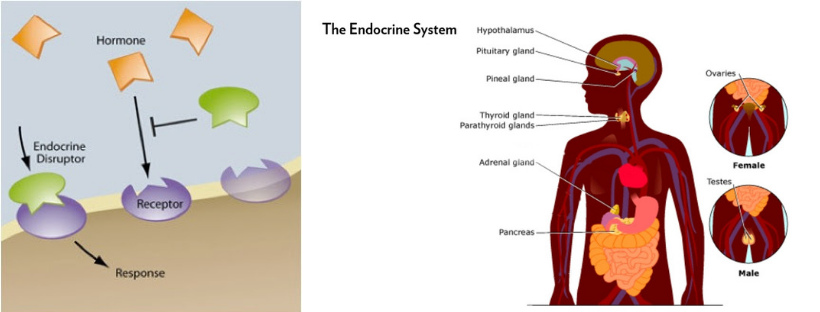01
Jul
Act on EPA’s Failure to Regulate Endocrine Disruptors, which Threatens Public Health
 (Beyond Pesticides, July 1, 2019) France made a decision in May to ban a widely-used fungicide because it damages the endocrine system. In contrast, there has been a stark failure to protect health in the U.S. Despite a Congressional mandate, EPA is not acting on endocrine disruptors linked to infertility and other reproductive disorders, diabetes, cardiovascular disease, obesity, and early puberty, as well as attention deficit hyperactivity disorder (ADHD), Parkinson’s, Alzheimer’s, and childhood and adult cancers. This is a tragedy.
(Beyond Pesticides, July 1, 2019) France made a decision in May to ban a widely-used fungicide because it damages the endocrine system. In contrast, there has been a stark failure to protect health in the U.S. Despite a Congressional mandate, EPA is not acting on endocrine disruptors linked to infertility and other reproductive disorders, diabetes, cardiovascular disease, obesity, and early puberty, as well as attention deficit hyperactivity disorder (ADHD), Parkinson’s, Alzheimer’s, and childhood and adult cancers. This is a tragedy.
In 1998, following a mandate in the Food Quality Protection Act (FQPA) of 1996, EPA established a program to screen and test pesticides and other widespread chemical substances for endocrine disrupting effects. Despite operating for 21 years, the Endocrine Disruptor Screening Program (EDSP) has made little progress in reviewing and regulating endocrine-disrupting pesticides. As of 2019, the program has stalled entirely.
To ensure appropriate follow-through, Congress gave EPA a timeline to: develop a peer-reviewed screening and testing plan with public input not later than two years after enactment (August 1998); implement screening and testing not later than three years after enactment (August 1999); and report to Congress on the findings of the screening and recommendations for additional testing and actions not later than four years after enactment (August 2000).
Despite these deadlines, EPA is stalled and ignoring its responsibility. It started a screening program (Tier 1) and reported results in 2009. According to EPA, Tier 1 Screening (which looks at high exposure chemicals) is not sufficient to implicate a chemical as an endocrine disrupting chemical. It is instead a step to define which chemicals must undergo Tier 2 testing – the only stage that can influence regulatory decision-making. It is unclear when or how EPA will move forward with Tier 2 testing, and how, if at all, any Tier 2 findings will be used to inform actual regulation.
Given widespread exposure to endocrine disruptors, the time is past due for EPA action.
Letter to Congress
I am writing to ask you elevate a critical public health issue –the regulation of endocrine disrupting pesticides. For over a decade, EPA ignored the vast wealth of information on endocrine disruption from independent academic researchers funded by the U.S. and other governments in Europe and Asia. EPA has simply not carried out its statutory mandate to regulate endocrine disrupting pesticides.
Endocrine disruptors are linked to infertility and other reproductive disorders, diabetes, cardiovascular disease, obesity, and early puberty, as well as to attention deficit hyperactivity disorder (ADHD), Parkinson’s, Alzheimer’s, and childhood and adult cancers. This is a public health tragedy that cannot be ignored.
Since EPA announced it was ready to begin testing both active and “inert” (usually the majority of the undisclosed product ingredients that make the solution, dust, or granule) pesticide ingredients for potential endocrine disrupting effects in 2009, the protocols EPA proposed to use have become significantly outdated, having been first recommended in 1998. In the interim, science has progressed such that it offered more sophisticated assumptions than those that informed the EPA test designs. Further, as Beyond Pesticides noted in 2009, “Each of EPA’s tests and assays was designed under the surveillance of corporate lawyers who had bottom lines to protect, and assorted toxicologists who were not trained in endocrinology and developmental biology. For over a decade, EPA ignored the vast wealth of information on endocrine disruption from independent academic researchers funded by the U.S. and other governments in Europe and Asia.”
In 1998, following a mandate in the Food Quality Protection Act (FQPA) of 1996, EPA established a program to screen and test pesticides and other widespread chemical substances for endocrine disrupting effects. Despite operating for 21 years, the Endocrine Disruptor Screening Program (EDSP) has made little progress in reviewing and regulating endocrine-disrupting pesticides.
To ensure timely follow-through, EPA was given a timeline by Congress to: develop a peer-reviewed screening and testing plan with public input not later than two years after enactment (August 1998); implement screening and testing not later than three years after enactment (August 1999); and report to Congress on the findings of the screening and recommendations for additional testing and actions not later than four years after enactment (August 2000).
Despite these deadlines, EPA is stalled and ignoring its responsibility. As of 2019, the program has stalled entirely. That has real costs. Please use the power of your office to push EPA to meet its responsibility to protect the health of people.
Thank you.










